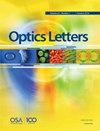全色散x射线光谱学低火焰角光栅。
IF 3.3
2区 物理与天体物理
Q2 OPTICS
引用次数: 0
摘要
我们演示了一种超低火焰角(LBA)光栅的制造,该光栅设计用于x射线区域的时间分辨光谱。通过减小凹槽深度的工艺,火焰角达到0.12°,使凹槽具有完美的锯齿形状。200线/mm LBA光栅在光子能量为8 KeV时具有较高的衍射效率。在光谱仪中使用将打开色散x射线吸收光谱在很宽的能量范围内,包括3d过渡金属的K边,比传统的晶体光谱仪效率更高。本文章由计算机程序翻译,如有差异,请以英文原文为准。
Low blaze angle grating for fully dispersive x-ray spectroscopy.
We demonstrate fabrication of an ultra-low blaze angle (LBA) grating designed for time-resolved spectroscopy in the x-ray region. A blaze angle of 0.12° was achieved by the groove depth reduction process providing a perfect saw-tooth shape of the grooves. The 200 lines/mm LBA grating exhibited high diffraction efficiency at a photon energy of 8 KeV. Use in a spectrometer would open up dispersive x-ray absorption spectroscopy across a wide energy range including the K edges of 3d transition metals, with much greater efficiency than traditional crystal spectrometers.
求助全文
通过发布文献求助,成功后即可免费获取论文全文。
去求助
来源期刊

Optics letters
物理-光学
CiteScore
6.60
自引率
8.30%
发文量
2275
审稿时长
1.7 months
期刊介绍:
The Optical Society (OSA) publishes high-quality, peer-reviewed articles in its portfolio of journals, which serve the full breadth of the optics and photonics community.
Optics Letters offers rapid dissemination of new results in all areas of optics with short, original, peer-reviewed communications. Optics Letters covers the latest research in optical science, including optical measurements, optical components and devices, atmospheric optics, biomedical optics, Fourier optics, integrated optics, optical processing, optoelectronics, lasers, nonlinear optics, optical storage and holography, optical coherence, polarization, quantum electronics, ultrafast optical phenomena, photonic crystals, and fiber optics. Criteria used in determining acceptability of contributions include newsworthiness to a substantial part of the optics community and the effect of rapid publication on the research of others. This journal, published twice each month, is where readers look for the latest discoveries in optics.
 求助内容:
求助内容: 应助结果提醒方式:
应助结果提醒方式:


